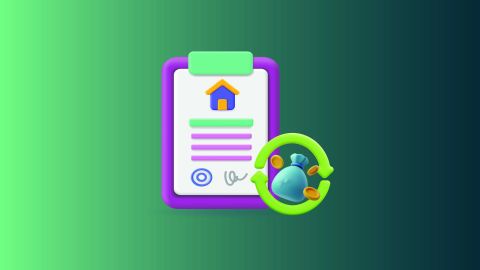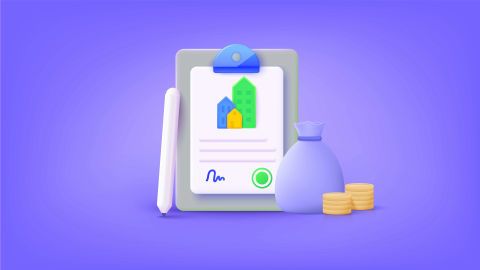प्रॉपर्टी पर लोन अब एक लोकप्रिय क्रेडिट इंस्ट्रूमेंट है क्योंकि इसका उपयोग करना आसान है और फाइनेंसिंग के उपयोगी स्रोत के रूप में काम कर सकता है. लेकिन अपने फाइनेंस को कुशलतापूर्वक प्लान करने और मैनेज करने के लिए, आपको अपने प्रॉपर्टी पर लोन पर लागू शुल्क को समझना होगा. इससे आपको लोन लेने की कुल लागत की स्पष्ट जानकारी मिलेगी और आपको पुनर्भुगतान के लिए बजट बनाने में मदद मिलेगी.
अपने मॉरगेज लोन पर लागू विभिन्न शुल्क देखें.
जब आप प्रॉपर्टी पर लोन के लिए सही लोनदाता चुनते हैं, तो ब्याज दरों, प्रोसेसिंग फीस और दंड जैसे शुल्क को मैनेज करना आसान होता है. बजाज फाइनेंस के साथ, आप प्रतिस्पर्धी दरों और आसान ऑनलाइन लोन मैनेजमेंट का लाभ उठा सकते हैं. यह लोन न केवल आपको पर्याप्त फंड प्रदान करता है, बल्कि बिना किसी तनाव के पुनर्भुगतान को प्लान करने की सुविधा भी प्रदान करता है. यह सुनिश्चित करते हुए कि छिपे हुए शुल्कों का बोझ न पड़े और अपनी प्रॉपर्टी की वैल्यू का लाभ उठाकर काम करें. बजाज फाइनेंस के पारदर्शी और सुविधाजनक ऑफर के साथ स्मार्ट फाइनेंशियल प्लानिंग की दिशा में पहला कदम उठाएं! अप्रूवल के 72 घंटों* के भीतर अपनी प्रॉपर्टी पर ₹10.50 करोड़ तक का लोन पाएं.
प्रॉपर्टी पर लोन की ब्याज दर
ब्याज दर वह लागत है जिस पर लोनदाता आपको क्रेडिट देता है. इसकी गणना उस अवधि के लिए आपके द्वारा उधार ली गई कुल राशि पर की जाती है, जिसके लिए आप लोन ले रहे हैं. ब्याज दरों की गणना वार्षिक रूप से की जाती है और फिर प्रत्येक EMI के अनुपात में जोड़ा जाता है.
प्रॉपर्टी पर लोन सिर्फ पैसे नहीं देता है - यह आपको विशेष पुनर्भुगतान विकल्पों के साथ फाइनेंशियल स्वतंत्रता देता है. बजाज फिनसर्व प्रॉपर्टी पर लोन अपनी प्रतिस्पर्धी ब्याज दरों के साथ सबसे अलग है. इसके अलावा, हमारा सुरक्षित ऑनलाइन पोर्टल आपको अपने लोन को आसानी से ट्रैक और मैनेज करने में मदद करता है. चाहे आप पार्ट-प्री-पेमेंट या फोरक्लोज़र की योजना बना रहे हों, बजाज फिनसर्व यह सुनिश्चित करता है कि प्रोसेस आसान हो. इस किफायती क्रेडिट समाधान के साथ अपनी प्रॉपर्टी की क्षमता को अनलॉक करें और छिपे हुए खर्चों की चिंता किए बिना अपने फाइनेंशियल लक्ष्यों की जिम्मेदारी लें. बजाज फिनसर्व प्रॉपर्टी पर लोन के साथ, ₹750/लाख* से शुरू होने वाली कम EMI और लंबी पुनर्भुगतान अवधि का लाभ उठाएं.
प्रोसेसिंग शुल्क
प्रोसेसिंग फीस, जिसे एप्लीकेशन फीस, एडमिनिस्ट्रेशन की लागत को कवर करना, क्रेडिट चेक और प्रॉपर्टी के मूल्यांकन आदि भी कहा जाता है. यह राशि आपको डिस्बर्स होने से पहले कुल लोन राशि से काटी जाती है.
इन्हें भी पढ़े: बजाज फिनसर्व प्रॉपर्टी पर लोन प्रोसेस
स्टेटमेंट शुल्क
अधिकांश लोनदाता आपको ब्याज और मूलधन स्टेटमेंट के साथ-साथ लोन स्टेटमेंट के लिए शुल्क लेते हैं, जो आपको अपने लोन की प्रगति की निगरानी करने में मदद करते हैं. ये हार्ड कॉपी के रूप में आपको भेजे जाते हैं, और स्टेटमेंट शुल्क प्रिंटिंग की लागत को कवर करते हैं और उन्हें आपको भेजते हैं.
अधिकांश लोनदाता आपको ब्याज और मूलधन स्टेटमेंट के साथ-साथ लोन स्टेटमेंट के लिए शुल्क लेते हैं, जो आपको अपने लोन की प्रगति की निगरानी करने में मदद करते हैं. ये हार्ड कॉपी के रूप में आपको भेजे जाते हैं. लेकिन, लोनदाता प्रिंटिंग और आपको स्टेटमेंट भेजने के लिए शुल्क लगाएगा.
आप ऑनलाइन लोन मैनेजमेंट में स्विच करके इस शुल्क से बच सकते हैं, जो अधिकांश लोन प्रदाता ऑफर करते हैं. ऐसा एक लोनदाता बजाज फिनसर्व है, जो आपको अपने प्रॉपर्टी पर लोन के लिए ऑनलाइन लोन मैनेजमेंट प्रदान करता है. इसके अलावा, आप ग्राहक ID और पासवर्ड का उपयोग करके सुरक्षित बजाज माय अकाउंट ग्राहक पोर्टल में साइन-इन कर सकते हैं और अपनी सुविधानुसार सभी संबंधित लोन स्टेटमेंट एक्सेस कर सकते हैं.
EMI बाउंस शुल्क
EMI बाउंस शुल्क
₹1,500/- प्रति बाउंस.
"बाउंस शुल्क" का अर्थ होगा (i) किसी भी भुगतान साधन के अनादर; या (ii) भुगतान मैंडेट के अस्वीकृत होने या भुगतान मैंडेट के रजिस्ट्रेशन न होने या किसी अन्य कारण से संबंधित देय तारीख पर किश्त का भुगतान न करने के लिए शुल्क.
पेनल्टी ब्याज
अगर आप EMI भुगतान नहीं कर पाते हैं या लोन पर डिफॉल्ट करते हैं, तो आपको दंड ब्याज का भुगतान करना होगा. इसे ब्याज दर से अधिक लिया जाता है और इसकी गणना मासिक रूप से की जाती है. इसलिए, ऐसे शुल्क का भुगतान करने से बचने के लिए आप पहले से ही पुनर्भुगतान करने की योजना बना रहे हैं.
इन्हें भी पढ़े: होम लोन और प्रॉपर्टी पर लोन के बीच क्या अंतर है
पार्ट प्री-पेमेंट शुल्क
पार्ट प्री-पेमेंट शुल्क
पूरा प्री-पेमेंट
• टर्म लोन: पूरे प्री-पेमेंट की तारीख पर बकाया लोन राशि पर 4.72% तक (लागू टैक्स सहित)
• फ्लेक्सी टर्म लोन (फ्लेक्सी ड्रॉपलाइन): पूरे प्री-पेमेंट की तारीख पर पुनर्भुगतान शिड्यूल के अनुसार ड्रॉपलाइन लिमिट के 4.72% तक (लागू टैक्स सहित).
• फ्लेक्सी हाइब्रिड टर्म लोन: पूरे प्री-पेमेंट की तारीख पर पुनर्भुगतान शिड्यूल के अनुसार ड्रॉपलाइन लिमिट का 4.72% तक (लागू टैक्स सहित).
आंशिक प्री-पेमेंट
• टर्म लोन: आंशिक प्री-पेमेंट की तारीख पर प्रीपेड मूल लोन राशि का 4.72% तक (लागू टैक्स सहित)
• फ्लेक्सी टर्म लोन (फ्लेक्सी ड्रॉपलाइन) और फ्लेक्सी हाइब्रिड टर्म लोन
के लिए लागू नहीं
ध्यान दें: - अगर सभी उधारकर्ता और सह-उधारकर्ता व्यक्ति हैं, तो फ्लोटिंग ब्याज दरों पर लिए गए लोन और बिज़नेस उपयोग के अलावा अन्य उद्देश्य के लिए लिए गए लोन पर कोई फोरक्लोज़र/पार्ट पेमेंट शुल्क नहीं लिया जाएगा
फोरक्लोज़र शुल्क
कोई फोरक्लोज़र शुल्क नहीं*
अगर सभी उधारकर्ता और सह-उधारकर्ता कंपनी या बिज़नेस न होकर कोई व्यक्ति हैं, तो फ्लोटिंग ब्याज दरों पर लिए गए लोन और बिज़नेस उपयोग के अलावा अन्य उद्देश्यों के लिए, लिए गए लोन पर कोई फोरक्लोज़र/पार्ट-प्री-पेमेंट शुल्क नहीं लिया जाएगा.
सिक्योर फीस
लोनदाता आपके अकाउंट, ट्रांज़ैक्शन और संवेदनशील जानकारी के लिए सुरक्षा को बढ़ावा देने के लिए सिक्योरिटी शुल्क लेते हैं. इसमें आपके ऑनलाइन अकाउंट की सुरक्षा करना और आपके सभी डेटा को सुरक्षित रखना शामिल है.
इसलिए, प्रॉपर्टी पर लोन लेते समय, कम ब्याज दर देखकर इसे न चुनें. इसके बजाय, निर्णय लेने से पहले प्रॉपर्टी पर लोन EMI कैलकुलेटर का उपयोग करें, ताकि आप कितनी किश्त का भुगतान कर सकें और शुल्कों की समीक्षा कर सकें.
प्रॉपर्टी के लिए आवश्यक सर्टिफिकेट
क्र. सं |
सर्टिफिकेट का प्रकार |
1 |
|
2 |
|
3 |
|
4 |
आपकी प्रॉपर्टी की क्षमता का उपयोग क्यों न होने दें? बजाज फिनसर्व प्रॉपर्टी पर लोन के साथ, आप प्रतिस्पर्धी दरों और न्यूनतम डॉक्यूमेंटेशन पर फंड प्राप्त कर सकते हैं. पारदर्शी शर्तें और ऑनलाइन लोन मैनेजमेंट टूल आपको अपने फाइनेंस के बारे में जानकारी प्राप्त करने में सक्षम बनाते हैं. यह लोन बड़े खर्चों को फंड करने या कर्ज़ को समेकित करने के लिए परफेक्ट है. इस कुशल क्रेडिट विकल्प के साथ अपनी प्रॉपर्टी की वैल्यू को बढ़ाएं और इसे आपके लिए काम करें. अपनी प्रॉपर्टी को कोलैटरल के रूप में उपयोग करके, आप ₹10.50 करोड़ तक के बड़े फंड का एक्सेस प्राप्त कर सकते हैं-यह अपने फाइनेंस को आसानी से मैनेज करने का एक स्मार्ट तरीका है! अप्रूवल के 72 घंटों* के भीतर पैसे पाएं.
अस्वीकरण:
हांलाकि यहां शामिल या उपलब्ध जानकारी, प्रोडक्ट और सेवाओं को अपडेट करने में सावधानी बरती जाती है हमारी वेबसाइट और संबंधित प्लेटफॉर्म/वेबसाइट, जानकारी को अपडेट करने में अनुचित गलतियां या टाइपोग्राफिकल एरर या देरी हो सकती है. इस साइट और संबंधित वेबपेजों में शामिल सामग्री संदर्भ और सामान्य जानकारी के उद्देश्य के लिए है और किसी भी असंगति की स्थिति में संबंधित प्रोडक्ट/सेवा डॉक्यूमेंट में उल्लिखित विवरण का पालन किया जाएगा. सब्सक्राइबर्स और यूज़र्स को यहां दी गई जानकारी के आधार पर आगे बढ़ने से पहले प्रोफेशनल सलाह लेनी चाहिए. कृपया संबंधित प्रोडक्ट/सेवा डॉक्यूमेंट और लागू नियमों और शर्तों को पढ़ने के बाद ही किसी भी प्रोडक्ट या सेवा के बारे में सोच-समझकर निर्णय लें. अगर कोई विसंगति दिखाई देती है, तो कृपया यहां क्लिक करें संपर्क जानकारी.
*नियम व शर्तें लागू




